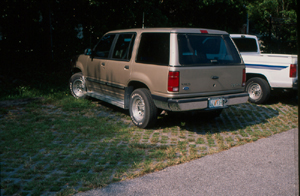Home > Urban/suburban design > Site modifications > Improving drainage
Improving drainage
 This alternate paving surface allows water to permeate the asphalt. Also, the design enables better soil aeration, which can improve root growth and overall tree health. |
Water running off a site can carry soil, pesticides and fertilizers which contribute to environmental degradation. Soil is often graded (shaped) to keep as much water on the site as possible.
Water can be channeled by creating subtle swales and berms providing better drainage over much of the site, but wetter conditions where water collects. This might improve drainage enough to expand the pallet of trees suited for the site. In most instances, redirected water should be kept on site, not channeled to streets or streams. This reduces runoff and sedimentation in streams by allowing it to percolate through the soil or evaporate.
Grade changes are common on large-scale landscape jobs, but often not practical for the homeowner. Consider installing gutters on a home or office building and directing water to an area that drains well. Or collect it in a cistern (large container) and use it for irrigation. French drains (a sloping trench filled with large stones) can also be constructed to channel water to a lower area. Be sure to divert runoff away from existing trees because flooding could kill them, especially if soil drains poorly.
Drainage in compacted soil can be improved by breaking through the compacted layer and into loose subsoil beneath. This allows water to flow into the underlying soil. This is normally done with a heavy piece of equipment.
Placing gravel by itself at the bottom of a planting area does not improve drainage or plant growth in wet soil. Excess water collected in the gravel layer must be piped to a lower area such as the street or sewer. Perforated pipe surrounded by geotextile fabric to keep soil from entering the pipe is recommended for this task. They are sometimes used to withdraw standing water out of the soil.
One or two vertical pipes are sometimes installed in the backfill soil in compacted soil with the hopes of improving aeration and root growth in the deeper soil depths. Studies show that they slightly improve aeration very close to the pipe but have little influence away from the pipe (Bassuk, 1993). To be effective, many vertical vent pipes may have to be installed very close together. In addition, some practitioners report that these devices clog with debris making them ineffective.
If the site is located in a low spot where surface water collects from surrounding areas, tilling or otherwise loosening the soil will not help. Correct this with underground or French drains, diversion ditches to prevent water from draining into the area, or adding soil to raise the elevation.

